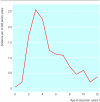Mumps, measles, and rubella vaccine and the incidence of autism recorded by general practitioners: a time trend analysis
- PMID: 11222420
- PMCID: PMC26561
- DOI: 10.1136/bmj.322.7284.460
Mumps, measles, and rubella vaccine and the incidence of autism recorded by general practitioners: a time trend analysis
Abstract
Objective: To estimate changes in the risk of autism and assess the relation of autism to the mumps, measles, and rubella (MMR) vaccine.
Design: Time trend analysis of data from the UK general practice research database (GPRD).
Setting: General practices in the United Kingdom.
Subjects: Children aged 12 years or younger diagnosed with autism 1988-99, with further analysis of boys aged 2 to 5 years born 1988-93.
Main outcome measures: Annual and age specific incidence for first recorded diagnoses of autism (that is, when the diagnosis of autism was first recorded) in the children aged 12 years or younger; annual, birth cohort specific risk of autism diagnosed in the 2 to 5 year old boys; coverage (prevalence) of MMR vaccination in the same birth cohorts.
Results: The incidence of newly diagnosed autism increased sevenfold, from 0.3 per 10 000 person years in 1988 to 2.1 per 10 000 person years in 1999. The peak incidence was among 3 and 4 year olds, and 83% (254/305) of cases were boys. In an annual birth cohort analysis of 114 boys born in 1988-93, the risk of autism in 2 to 5 year old boys increased nearly fourfold over time, from 8 (95% confidence interval 4 to 14) per 10 000 for boys born in 1988 to 29 (20 to 43) per 10 000 for boys born in 1993. For the same annual birth cohorts the prevalence of MMR vaccination was over 95%.
Conclusions: Because the incidence of autism among 2 to 5 year olds increased markedly among boys born in each year separately from 1988 to 1993 while MMR vaccine coverage was over 95% for successive annual birth cohorts, the data provide evidence that no correlation exists between the prevalence of MMR vaccination and the rapid increase in the risk of autism over time. The explanation for the marked increase in risk of the diagnosis of autism in the past decade remains uncertain.
Figures


Comment in
-
Measles, mumps, and rubella (MMR) vaccine and autism. Ecological studies cannot answer main question.BMJ. 2001 Jul 21;323(7305):163; author reply 164. BMJ. 2001. PMID: 11463692 Free PMC article. No abstract available.
-
Measles, mumps, and rubella (MMR) vaccine and autism. MMR cannot be exonerated without explaining increased incidence of autism.BMJ. 2001 Jul 21;323(7305):163-4. BMJ. 2001. PMID: 11484720 No abstract available.
-
Measles, mumps, and rubella (MMR) vaccine and autism. Argument is too simplistic.BMJ. 2001 Jul 21;323(7305):163; author reply 164. BMJ. 2001. PMID: 11484721 No abstract available.
-
Changes in risk of autism in the U.K. for birth cohorts 1990-1998.Epidemiology. 2003 Sep;14(5):630-2. doi: 10.1097/01.ede.0000082044.88833.c4. Epidemiology. 2003. PMID: 14501282 No abstract available.
References
-
- Wakefield AJ, Murch SH, Anthony A, Linell J, Casson DM, Malik M, et al. Ileal-lymphoid-nodular hyperplasia, non-specific colitis, and pervasive developmental disorder in children. Lancet. 1998;351:637–641. - PubMed
-
- Taylor B, Miller E, Farrington CP, Petropoulos M-C, Favot-Mayaud I, Li J, et al. Autism and measles, mumps, and rubella vaccine: no epidemiological evidence for a causal association. Lancet. 1999;353:2026–2029. - PubMed
-
- Wakefield AJ. MMR vaccination and autism. Lancet. 1999;354:949–950. - PubMed
-
- Jick H. A database worth saving. Lancet. 1997;350:1045–1046. - PubMed
MeSH terms
Substances
Grants and funding
LinkOut - more resources
Full Text Sources
Miscellaneous
